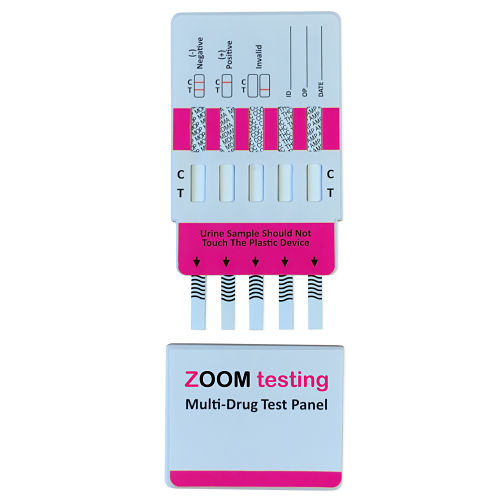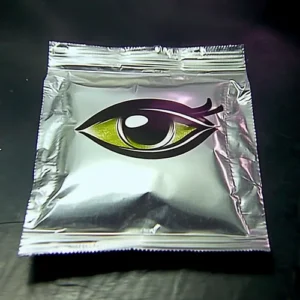About This Article
Zoom Testing has supplied drug testing kits to UK customers for nearly 20 years. This guide draws on our experience helping thousands of people understand home drug testing, workplace compliance, and accurate test interpretation. Always follow current UK legislation regarding drug testing.
Published: July 2023 | Last Updated: November 2025 | By Anthony Cunningham
Home drug testing kits are tools that can help determine if a person is using drugs. They can check for the presence of dangerous substances including cannabis, opiates, cocaine, MDMA, amphetamines, and benzodiazepines.
Whilst home drug testing is popular among parents of teenagers, it is also used in schools, offices, and business organisations. Compared to testing in a lab, these tests offer a practical and cost-effective solution. However, it’s crucial to handle home drug test kits with proper care and understanding.
Contents
Make Sure the Test Kit is Reliable
Before purchasing a test kit, verify it meets professional standards. Look for CE marking, which indicates European conformity, or approval from scientific bodies such as the US Food and Drug Administration (FDA). These certifications ensure the test has been properly validated for accuracy and reliability.
The test should be capable of detecting the specific drugs you suspect might be present. Keep in mind that home drug tests typically provide qualitative results, meaning they show whether a drug is present or absent, not the exact quantity. According to SAMHSA guidelines, professional-grade tests use specific cut-off levels to determine positive results.
Key Quality Indicators
- CE marking or FDA approval
- Clear expiry date printed on packaging
- Sealed, tamper-evident packaging
- Detailed instructions in English
- Specific cut-off levels stated for each drug
- Customer reviews and established supplier reputation
Understanding Different Test Types
Home drug tests come in several formats, each with specific advantages. Choosing the right type depends on your testing needs and circumstances.
Dip Cards and Test Strips
Dip cards are the most common format for multi-drug testing. They test multiple substances simultaneously using a single urine sample. The non-flood design allows full immersion without contamination, and results appear within five minutes.
Single-drug test strips work similarly but focus on one specific substance. These are ideal when you need to monitor for a particular drug, such as cannabis or cocaine.
Integrated Drug Test Cups
All-in-one testing cups combine sample collection and testing in one device. These are particularly useful for workplace drug testing as they include temperature strips to verify sample freshness and reduce tampering opportunities.
Saliva Drug Tests
Saliva tests offer a less invasive alternative to urine testing. They detect recent drug use, typically within the past 24-48 hours. These tests are increasingly popular for roadside screening and situations where immediate supervision is required.
Follow the Instructions Carefully
Carefully read and follow all directions before conducting any drug test. Even a minor error can produce inaccurate results. Pay close attention to timing requirements, as tests have specific windows for reading results accurately.
Before using the test, verify the expiry date on the packaging. Expired tests may not function correctly and can give false results. Store tests in a cool, dry place away from direct sunlight until needed.
Pre-Test Checklist
- Check the expiry date on the test packaging
- Ensure the test has been stored properly (room temperature, dry conditions)
- Read all instructions completely before starting
- Prepare a clean collection area
- Have a timer or watch available for accurate timing
- Ensure good lighting to read results clearly
Step-by-Step Testing Process
Following a systematic approach ensures accurate results and reduces the chance of errors. Here’s the complete process for using a urine drug test kit.
Step 1: Collect the Sample
Use a clean, dry collection cup. The sample should be collected in a private area, but you may need to maintain visual or auditory supervision depending on your testing circumstances. According to UK government guidance, proper sample collection is essential for valid results.
Mid-stream urine is preferred, as the first part of urination may contain contaminants. Collect at least 30ml of urine for adequate testing. The sample should be tested within one hour of collection for most accurate results.
Step 2: Prepare the Test Device
Remove the test from its sealed pouch immediately before use. Do not touch the test strips or reactive zones, as oils from your hands can interfere with results. Write the date, time, and tested person’s identifier on the test card if required.
Step 3: Apply the Sample
For dip cards, immerse the test into the urine sample up to the maximum fill line indicated on the device. Do not submerge past this line. Hold the test in the sample for the specified time, typically 10-15 seconds. Remove and place the test on a flat, clean surface.
For test strips, dip the absorbent end into the sample for the exact time stated in the instructions. Different tests may require different immersion times.
Step 4: Wait for Results
Set a timer for the exact development time specified in the instructions, usually five minutes. Do not read results before this time, as they may still be developing. Equally important, do not read results after the maximum time window (typically 10 minutes), as they may no longer be accurate.
Step 5: Interpret and Record
Read results in good lighting. Take a photo for your records if needed, as some tests may fade over time. Document the date, time, and results immediately.
Ready to Test? Our multi-drug dip cards detect multiple substances in minutes with professional accuracy. Now that you know how to use them, get the reliable testing kits trusted by thousands of UK customers.
Prevent Cheating and Sample Tampering
Some people may attempt to falsify results on a home drug test by diluting their urine with excessive water or using additives to alter the sample composition. Taking precautions helps ensure accurate results.
Anti-Tampering Measures
- Maintain visual or auditory supervision during sample collection
- Check the temperature of the sample immediately after collection (should be 32-38°C)
- Use tests with adulterant detection strips that identify dilution or chemical additives
- Restrict access to water and other fluids before testing
- Ensure the testing area has no access to cleaning products or additives
- Conduct random, unannounced testing when possible
Many modern test cups include validity checks for specific gravity, pH, and creatinine levels. These help identify diluted or adulterated samples. If validity indicators suggest tampering, a fresh sample should be collected under closer supervision.
Reading and Interpreting Results
Understanding how to correctly interpret test results is crucial. Misreading results can lead to incorrect conclusions and potentially serious consequences.
Negative Results
A negative result means the drug concentration is below the test’s cut-off level. Two lines will appear: one in the control region (C) and one in the test region (T). The test line may be faint, but any visible line in the test region indicates a negative result.
The intensity of the test line does not indicate drug concentration. A faint line is just as negative as a dark line. This is a common source of confusion, and many customers contact us about faint lines. Rest assured, any line is negative.
Positive Results
A positive result means drug concentration exceeds the cut-off level. Only one line will appear, in the control region (C). No line appears in the test region (T). This indicates the presence of the drug above the threshold.
For information about drug test cut-off levels, consult our detailed guides on specific substances.
Invalid Results
An invalid result occurs when no control line appears, or when the test behaves unexpectedly. This means the test has not worked correctly. Do not attempt to interpret an invalid test. Discard it and repeat the test with a new device.
When to Seek Confirmation Testing
Home drug tests are screening tools, not diagnostic tests. Consider professional laboratory confirmation when:
- A positive result has serious consequences (employment, legal matters)
- The tested person disputes the result
- You need legally defensible documentation
- Results will inform medical treatment decisions
Common Mistakes to Avoid
Even with clear instructions, certain errors occur frequently. Avoiding these common pitfalls will improve your testing accuracy.
Timing Errors
Reading results too early or too late is the most frequent mistake. Always use a timer and read results within the specified window. Results read outside this timeframe may be inaccurate.
Sample Issues
Using an insufficient sample volume, testing old samples, or allowing samples to sit too long before testing can all cause problems. Test samples within one hour of collection when possible.
Storage Problems
Tests stored in humid conditions, extreme temperatures, or past their expiry date may not function correctly. Always check storage requirements and expiry dates.
Misinterpreting Faint Lines
Many people worry that a faint test line means a “barely negative” result. This is not the case. Any visible line in the test region, regardless of intensity, indicates a negative result. Line intensity varies between tests and individuals.
Quick Troubleshooting Guide
- No control line appears: Test is invalid, repeat with new device
- Results appear before time limit: Wait until full development time before reading
- Colour runs across test: Too much sample used, repeat test
- Test line is very faint: Still negative if any line is visible
- Results fade after reading: Take photo immediately for records
What Customers Say
Our customers regularly share their experiences using drug testing kits. Here’s what some have said about the testing process:
“These tests were spot on with my son, worked well and very easy to do.”
— Emma P., Verified Customer
“I’ve never taken drugs or used a drug test before so it was a bit intimidating at first but I contacted Zoom Testing and they were very helpful in pointing me in the right direction. The test was simple to use and I now have peace of mind. Results of the test give a clear positive or negative. Good deterrent too, as he knows that he can be tested at any time.”
— Tina, Verified Customer
“I bought these so that I could test my teenager. The kits arrived very quickly and with full instructions. Test itself was easy to use and I would recommend this item to any parent in a similar situation to me. Results of the test give a clear positive or negative.”
— Sarah H., Verified Customer
Final Thoughts
Using home drug testing kits can help discourage drug use and provide peace of mind for parents, employers, and individuals. However, it is important to use them responsibly, follow all instructions accurately, and understand their limitations as screening tools.
Always maintain confidentiality and handle results sensitively. If you have questions about testing procedures, interpreting results, or choosing the right test for your needs, our team at Zoom Testing is here to help.
For more information about specific drugs and detection times, explore our comprehensive guides on cocaine testing, opioid detection, and workplace drug testing protocols.
About the Author
Anthony Cunningham – Drug Testing Expert & Editor
Anthony Cunningham, BA (Hons), MA, is a UK-based drug testing expert and editor with over 20 years’ experience running Zoom Testing, a trusted source for accurate drug testing kits and testing guidance. He creates clear, evidence-based articles using UK legislation, workplace compliance standards, and harm reduction best practices. Where possible, content is reviewed by testing specialists and compliance professionals to enhance accuracy and reliability, helping readers make informed testing decisions.






